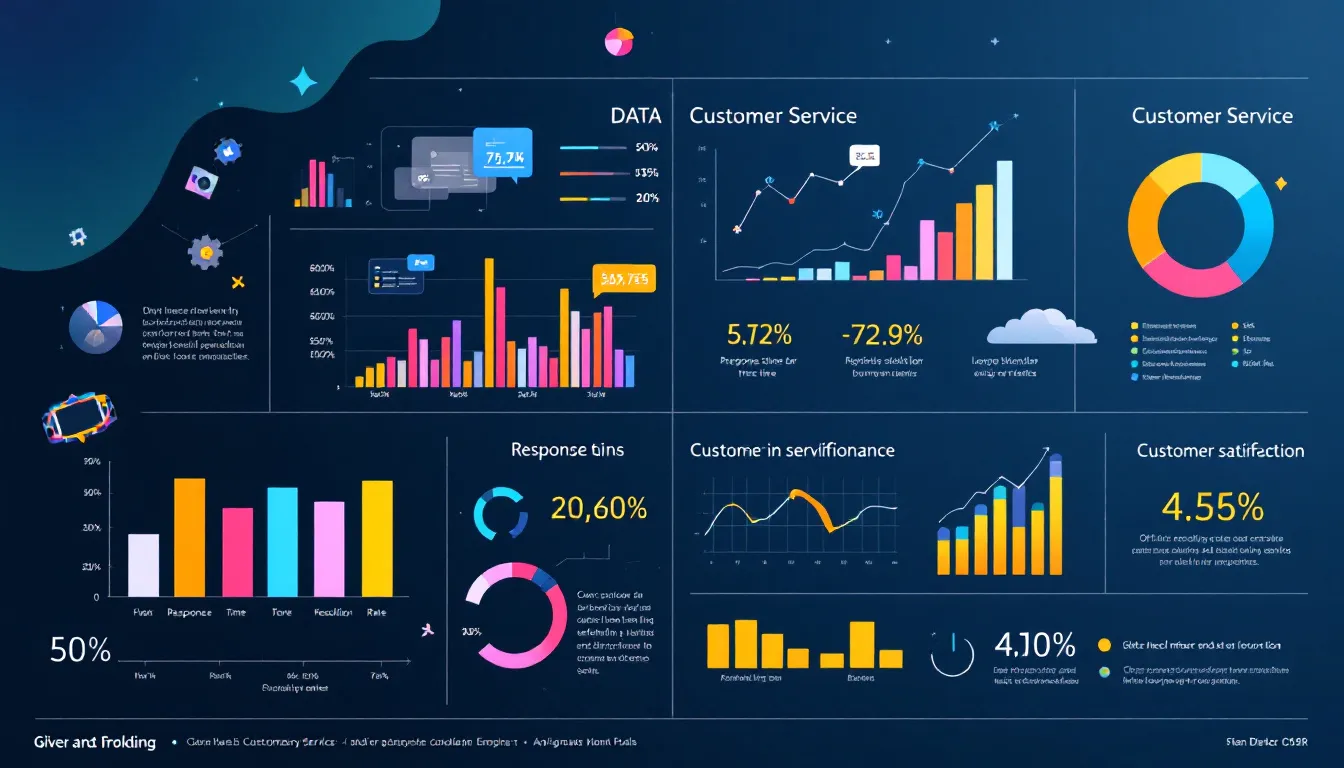Understanding Key Performance Indicators in Customer Service

Key Performance Indicators, or KPIs, are essential tools that help customer service teams assess their effectiveness and align their performance with broader business objectives. A key performance indicator offers a clear framework for identifying strengths and weaknesses, supporting data-driven decisions, and promoting continuous improvement through goal setting and evaluation.
Customer service metrics, a subset of customer service kpi, are particularly focused on measuring the quality of service, identifying areas for improvement, and enhancing customer satisfaction. These key metrics are vital for minimizing customer pain points, reducing dissatisfaction, and preventing churn. Moreover, issue resolution KPIs highlight performance levels and pinpoint areas needing improvement, ensuring that service quality is consistently high.
Understanding financial metrics is vital. It helps in diagnosing cost-effectiveness and profitability in customer service operations. By tracking these metrics, teams can optimize performance and contribute to overall business growth through effective customer experience management. The Net Promoter Score (NPS), for example, is a powerful indicator of customer satisfaction and can drive word-of-mouth marketing.
What Are Key Performance Indicators for Customer Success Teams?
Key Performance Indicators (KPIs) are metrics that help identify strengths and weaknesses in an organization and support data-driven decision-making.
They serve as measurement tools for gauging both employee and company performance, focusing on various aspects such as efficiency, quality, and speed of support interactions. In the context of customer service, KPIs provide insights into customer satisfaction, response speed, and the overall effectiveness of the support team.
The role of KPIs is not just about measurement but also about setting and achieving goals. They help track progress towards key business objectives and facilitate better decision-making. However, selecting the right customer service metrics can be challenging, as each organization has unique needs and goals. Executives and managers must agree on what to measure before tracking these metrics.
Why KPIs Matter for Customer Service Teams?
Monitoring KPIs is vital for analyzing the strengths and weaknesses of the customer service department. Tracking these metrics provides valuable insights into team performance and customer satisfaction levels. This, in turn, helps streamline operations and ensures that support teams meet the required performance standards.
Effective KPI monitoring keeps customers engaged by identifying areas needing improvement and enhancing overall team performance. Improving customer service with leading and lagging kpis fosters loyalty and retention, directly impacting business outcomes.
Greater customer satisfaction leads to improved retention and referrals, which are crucial to improve customer satisfaction and retain customers for long-term success. Satisfied customers are essential for achieving these goals.
Essential Customer Satisfaction Metrics

Metrics that measure customer satisfaction are critical for understanding customer loyalty and enhancing customer experiences. These KPIs can reveal service gaps and promote long-term customer loyalty, which is more cost-effective than acquiring new customers. A high customer retention rate indicates loyalty and contributes to predictable revenue streams.
Identifying customers likely to churn can help refine retention strategies and reduce dissatisfaction. It’s important to choose the right metrics, as each organization has unique needs and goals in customer service.
Customer Satisfaction Score (CSAT)
The Customer Satisfaction Score (CSAT) gauges customer satisfaction with particular support interactions and helps improve the customer satisfaction rate. It provides insights into the effectiveness of customer service. Typically tracked through automated customer surveys post-issue resolution, CSAT feedback is gathered through brief post-interaction surveys or feedback forms, contributing to overall customer satisfaction scores.
A CSAT score range of 75-85% is considered impressive, indicating high levels of customer satisfaction.
Net Promoter Score (NPS)
The Net Promoter Score (NPS) is a metric for assessing customer loyalty based on the likelihood of customers recommending the business. It is calculated by:
Identifying promoters: customers rating the business 9 or 10
Identifying detractors: customers rating the business 0 to 6
Subtracting the percentage of detractors from the percentage of promoters
Industry benchmarks indicate that an NPS above 50% is good, while scores above 75% are considered excellent.
Customer Effort Score (CES)
The Customer Effort Score (CES) evaluates how easy it is for customers to resolve their issues, highlighting areas where process improvements are needed. CES can be tracked by asking customers to rate their resolution experience from easy to difficult, with the goal being to keep the score as low as possible. A CES score of 5 and higher indicates that customers received helpful support.
Tracking CES not only helps identify process inefficiencies but also contributes to enhancing overall customer satisfaction. Easing issue resolution for customers enhances loyalty and satisfaction levels.
Response Time Metrics

Response time metrics are crucial for gauging how promptly customer service interactions occur, directly influencing customer satisfaction. Average response time measures the time taken for agents to respond to customer inquiries, and high abandonment rates can indicate long wait times and a poor customer experience.
First Response Time (FRT)
First Response Time (FRT) is the time between a customer sending a support ticket and the agent’s initial response. Faster response times increase customer trust and prevent frustration, making it crucial to keep the average response time low.
Effective tracking of FRT involves tagging timestamps of incoming tickets and comparing them to response times.
Average Handle Time (AHT)
Average Handle Time (AHT) measures the duration of customer service interactions, including communication and follow-up actions. It is particularly relevant for phone support, indicating the team’s efficiency in handling customer issues. Typically, the benchmark for AHT varies between 2 and 5 minutes depending on the industry.
Average Resolution Time
Average Resolution Time helps evaluate the efficiency of customer service by measuring the total time taken to resolve support tickets from start to finish. Lower Average Resolution Times indicate quicker resolutions, enhancing overall customer satisfaction. The Average Time to Resolution (ATR) varies by communication channel: 5 minutes for phone calls, 2 hours for email, and 10 minutes for live chat.
Tracking Average Resolution Time is vital as it reveals the average duration taken to completely resolve customer support tickets. Improving this metric contributes to better customer satisfaction and loyalty.
Efficiency and Operational Metrics

Efficiency KPIs in customer service are essential for balancing operational costs and resources while ensuring superior service delivery. Satisfaction scores like CSAT and NPS, along with operational indicators like response time and resolution rates, are critical for measuring efficiency.
Tracking these metrics helps identify potential issues and bottlenecks in meeting customer targets.
First Contact Resolution Rate (FCR)
First Contact Resolution Rate (first contact resolution fcr) measures the percentage of support issues resolved during the first interaction, indicating efficiency and knowledgeable representatives. FCR can be tracked by measuring tickets closed after initial communication and calculated using the formula: Number of resolved tickets / Total number of tickets * 100.
Improving FCR can include providing self-service tools and offering multiple communication channels.
Number of Tickets
The Number of Resolved Tickets KPI measures the tickets received and resolved by agents over a specific time. Tracking this metric provides insights into customer demands, staffing needs, support costs, agent workload, service desk kpis, and resource allocation.
Understanding the number of tickets by medium is important as it indicates resource allocation needs based on inquiry sources.
Service Level Agreement (SLA) Compliance
SLA compliance demonstrates adherence to customer service commitments, reflecting operational reliability and impacting customer satisfaction and retention. SLA compliance is measured as the percentage of tickets solved within the SLA time frame, calculated by dividing the number of tickets resolved within SLA by the total tickets.
The goal for SLA compliance adherence is to achieve as close to 100% adherence as possible, with strategies including adjusting metrics based on historical data with specific customers.
Employee Performance and Engagement Metrics
Metrics in this section evaluate how effectively customer service representatives perform and how engaged they feel in their roles. Recognizing top-performing representatives motivates the team. It fosters an environment of hard work and dedication.
Metrics not only focus on performance but also reflect employees’ engagement, which is critical for overall service quality.
Top Performing Reps
Tracking metrics related to high-performing agents provides insights into team strengths and areas for potential improvement. Analyzing these performance metrics highlights where the team excels and aspects that could be further optimized.
Identifying high-ticket agents can improve team efficiency and strengthen customer relationships.
Employee Satisfaction (ESAT)
Employee satisfaction (ESAT) is typically measured through surveys or feedback mechanisms. The eNPS (Employee Net Promoter Score) measures employee satisfaction, with higher ESAT scores indicating increased motivation, morale, and goal attainment.
Employee satisfaction is linked to better service quality and increased productivity. Additionally, job satisfaction plays a significant role in enhancing employee retention.
Agent Touches Per Ticket
Agent touches refer to the customer interactions between the customer support team members and a customer ticket in the customer service operation. Customers contact prefer quick resolutions without constant back and forth during problem resolution, which is why outstanding customer service agents are essential to resolve customer issues resolved.
Agent touches per ticket is calculated by dividing total communications by the number of cases, with high agent touches often indicating inefficiencies in the problem resolution process.
Financial and Business Impact Metrics

Financial performance metrics help organizations link customer service outcomes with revenue growth. Optimizing customer service leads to increased customer loyalty, reduced service costs, and ultimately, service performance and revenue growth.
Tracking these metrics results in higher efficiency, cost savings, and greater agent engagement, enhancing operational efficiency.
Cost Per Contact
The cost per contact metric measures the average cost incurred for each customer interaction. Organizations can use this metric to identify cost savings opportunities, improve budgeting, and resource allocation.
The formula for calculating Cost Per Resolution is total operating expenses divided by the number of tickets resolved.
Customer Lifetime Value (CLV)
Customer Lifetime Value (CLV) reflects the overall net profit generated from customers. This calculation spans the entire duration of their relationship with the company. CLV takes into account initial purchases and repeat purchases. It also considers the average duration of the customer relationship in its calculation.
It measures the profitability of customer relationships over time.
Churn Rate
Churn Rate measures the rate at which customers stop doing business with an organization. It is calculated as the percentage of customers who cease their relationship with the company over a given period. Monitoring churn rates helps companies identify patterns that may lead to customer loss, allowing them to implement strategies to improve retention.
A high retention rate leads to improved lifetime customer value and profitability, making churn rate a critical metric for financial health. By reducing churn, companies can maintain a steady revenue stream and enhance overall business success.
Self-Service and Knowledge Base Metrics
In the digital age, self-service options are becoming increasingly important for customer service teams. Metrics that track the usage and effectiveness of these resources can provide valuable insights into customer preferences and service quality and inform customer service efforts.
Effective self-service tools empower customers, reduce the load on support teams, and lower support costs.
Knowledge Base Views
Tracking Knowledge Base Views helps measure the usage and effectiveness of self-service options provided to customers, including addressing customer queries. More than 80% of customers use a company’s FAQs and self-service portals, indicating their importance.
Knowledge base views can be tracked using a tracking code to monitor engagement, identifying popular knowledge base articles and areas where customers struggle.
Self-Service Utilization
Self-Service Utilization tracks the use of self-service resources like knowledgebases instead of contacting support. This metric indicates how often customers prefer to resolve issues independently using online resources, which can enhance customer satisfaction and reduce the workload on support teams. Analytics tools can be used to monitor self-service resource views and interactions, providing insights into customer behavior and the effectiveness of self-service tools.
Encouraging self-service streamlines support operations, reduces costs, and boosts customer satisfaction. Self-service tools empower customers to find solutions quickly and independently, leading to a more efficient and satisfying customer service experience.
Abandonment Rate
A high rate of abandonment during self-service indicates potential issues with resource accessibility or clarity. The abandonment rate measures how often customers leave the self-service process before completing their interaction.
Monitoring this metric helps identify issues in customer self-service processes, allowing organizations to improve resource clarity and accessibility, thereby reducing abandonment rates and enhancing the overall customer experience.
Summary
In summary, tracking KPIs in customer service is essential for measuring performance, identifying areas for improvement, and enhancing customer satisfaction. From customer satisfaction metrics like CSAT, NPS, and CES, to response time and efficiency metrics, each KPI plays a critical role in optimizing customer service operations. By monitoring these metrics, organizations can ensure they meet customer expectations, improve service quality, and drive business success.
Ultimately, the goal of tracking KPIs is to create a more efficient, effective, and customer-centric service operation. By leveraging these metrics, customer service teams can foster loyalty, boost retention, and contribute to the overall growth and profitability of the business. Remember, outstanding customer service is not just about solving problems but about creating memorable and positive experiences for customers.
These KPIs also help build your resume and showing a quantifiable results in your resumes can make it stronger.
These customer service KPIs not only elevate organizational performance but also strengthen your customer service resume —showing measurable results such as higher CSAT scores, faster response times, or improved retention rates on your resume demonstrates impact, boosts credibility, and helps you stand out to potential employers.
Key Takeaways?
Key Performance Indicators (KPIs) are essential for customer service teams to measure performance, identify strengths and weaknesses, and drive continuous improvement.
Metrics such as Customer Satisfaction Score (CSAT), Net Promoter Score (NPS), and Customer Effort Score (CES) are critical for analyzing customer satisfaction and loyalty, helping to reduce churn and enhance service quality.
Efficiency metrics like First Response Time (FRT) and Average Handle Time (AHT) are necessary for evaluating operational effectiveness and ensuring timely customer support.
Frequently Asked Questions
What are Key Performance Indicators (KPIs)?
KPIs are essential metrics that reveal an organization’s strengths and weaknesses, enabling data-driven decision-making. They measure efficiency, quality, and speed, offering insights into customer satisfaction and team performance.
Why are customer satisfaction metrics important?
Customer satisfaction metrics are essential because they provide insights into customer loyalty and experience, highlighting service gaps and informing retention strategies. By leveraging these metrics, businesses can foster long-term loyalty and enhance overall customer satisfaction.
How does Average Handle Time (AHT) impact customer service?
Average Handle Time (AHT) directly impacts customer service by reflecting the efficiency of the team in resolving issues promptly. A lower AHT can lead to increased customer satisfaction, as customers appreciate quicker resolutions.
What is the significance of the First Contact Resolution Rate (FCR)?
The First Contact Resolution Rate (FCR) is crucial as it reflects the efficiency of support teams in resolving issues during the first interaction, ultimately enhancing customer satisfaction and reducing frustration. A higher FCR signifies a more effective service experience and knowledgeable representatives.
How do self-service metrics benefit customer service teams?
Self-service metrics significantly enhance customer service teams by enabling them to track the usage and effectiveness of self-service options, thereby empowering customers to resolve their issues independently. This not only alleviates the workload on support teams but also boosts overall customer satisfaction.









